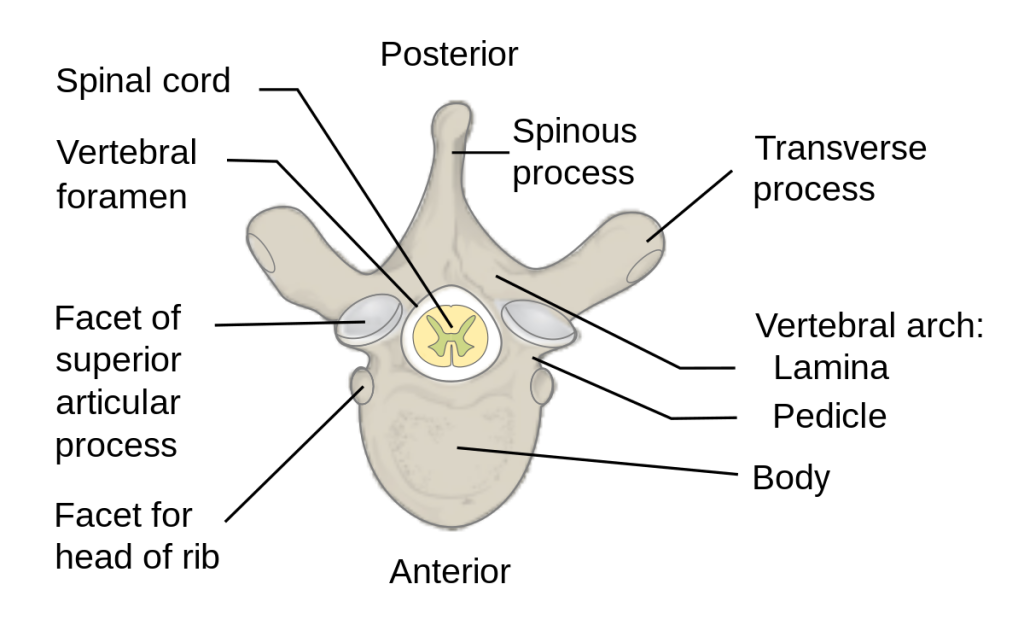Anatomy of The Spine
Published (updated: ).

The vertebral column supports the body’s physical structure and nervous system, enabling movement and sensation. Pathology of the spine can lead to debilitating outcomes on quality of life. The vertebral column (spine) defines the animal subphylum Vertebra, or vertebrates, of the phylum Chordata. In humans, it is composed of 33 vertebrae that include 7 cervical, 12 thoracic, 5 lumbar, 5 sacral, and 4 coccygeal. Along with the skull, ribs, and sternum, these vertebrae make up the axial skeletal system.
Protection of the Spinal Cord and Spinal Nerves

The spinal canal, a central lumen within each vertebral body, contains the spinal cord. Spinal nerves emerge from the main cord at each vertebral level to make up the sympathetic trunk and splanchnic nerves. The diameter of the spinal canal changes in the different parts of the vertebral column, larger in the cervical and lumbar regions and smaller in the thoracic region.
Structural Support
The spinal column forms the central axis of weight-bearing and supports the head as well as transfers the weight of the trunk and abdomen to the legs.
Provide Structure and Flexibility to the Body
- Movement: The unique jointed structure of the spine allows rotation and bending.
- In the thoracic region, the spine provides attachment sites for ribs.
- The spine serves as the attachment site for multiple muscles.
Intervertebral Discs: Provide Cushioning Between the Vertebrae

- Intervertebral discs are cartilaginous structures between adjacent vertebrae composed of annulus fibrosus and nucleus pulposus.
- The discs comprise about 25% of the length of the vertebral column.
- They support the anterior and posterior longitudinal ligaments.
Nerves
The nervous system is split into 2 systems: the central nervous system (CNS), which is composed of the brain and spinal cord, and the peripheral nervous system, which consists of spinal nerves, cranial nerves, and their ganglia. The spinal cord is contained within the vertebral column. Thirty-one pairs of spinal nerves exit the spinal cord and pass through the intervertebral foramen to innervate the periphery. Meningeal branches of spinal nerves innervate the vertebrae.
Muscles
As the central weight-bearing bony structure, the spine undergoes tremendous force. The muscles that attach to the spine help maintain posture and distribute the uneven force of the body’s weight. They are divided into extrinsic and intrinsic back muscle groups.
The extrinsic muscles are further divided into superficial (trapezius, latissimus dorsi, levator scapulae, and the major and minor rhomboids) and intermediate (serratus posterior superior and serratus posterior inferior) groups. The superficial extrinsic muscles are involved in the movement of the upper limbs including movements of the scapula and humerus. The intermediate extrinsic muscles are involved in the rib movement to aid respiration.
The intrinsic back muscles are separated into 3 layers: superficial, intermediate, and deep. These muscles aid in the movement of the spine and maintain postures. The superficial layer is made of the splenius capitis and splenius cervicis. These are involved in neck flexion, rotation, and extension. The intermediate layer is mostly made of the paraspinal or erector spinae muscles, the iliocostalis, longissimus, and spinalis. As the name implies, the erector spinae are important in extending and maintaining the central curvature of the spine.
The adult spine is normally curved slightly with cervical lordosis, thoracic kyphosis, and lumbar lordosis. This curvature originates during embryogenesis and further develops during childhood. Thoracic kyphosis and sacral curvature are formed during fetal development, known as the “fetal position.” Cervical curvature develops when babies begin to support the weight of their heads. Lumbar lordosis develops when children begin to stand and support their body weight. This curvature may become exaggerated or abnormal due to various pathological processes.
